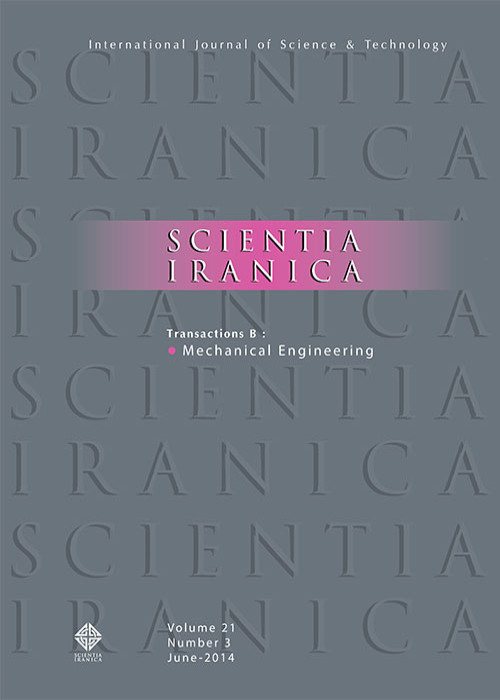A new nondominated sorting genetic algorithm based to the regression line For fuzzy traffic signal optimization problem
Author(s):
Article Type:
Research/Original Article (دارای رتبه معتبر)
Abstract:
Traffic jam is a daily problem in nearly all major cities in the world and continues to increase with population and economic growth of urban areas. Traffic lights, as one of the key components at intersections, play an important role in control of traffic flow. Hence, study and research on phase synchronization and time optimization of the traffic lights could be an important step to avoid creating congestion and rejection queues in a urban network. Here, we describe the application of NSGA-II, a multi-objective evolutionary algorithm, to optimize both vehicle and pedestrian delays in an individual intersection. Results show that parameters found by improved NSGA-II can be superior to those defined by a traffic engineer with respect to several objectives, including total queue length of vehicles and pedestrians.
In this paper, we improve NSGA-II algorithm based to the regression line to find a Pareto-optimal solution or a restrictive set of Pareto-optimal solutions based on our solution approaches to the problem, named PDNSGA (Non-dominated Sorting Genetic Algorithm based on Perpendicular Distance). In this paper, our purpose is to present a solution methodology to obtain all Pareto-optimal solutions to optimize traffic signal timing and enable the decision-makers to evaluate a greater number of alternative solutions. The proposed algorithm has the capability of searching Pareto front of the multi-objective problem domain. Further jobs should be concerned on the signal timing optimization method for the oversaturated coordinated intersections or small-scale road network and real-field applications with the traffic signal controller. The high speed of the proposed algorithm and its quick convergence makes it desirable for large scheduling with a large number of phases. Furthermore, we have used the mean deviation from the ideal point (MDI) measure to compare the performance of the MOGA, PDNSGA, NSGA-II, and WBGA by the ANOVA method. It is demonstrated that the our proposed algorithm (PDNSGA) gives better outputs than those of MOGA, NSGA-II, and WBGA in traffic signal optimization problem, statistically .
In this paper, we improve NSGA-II algorithm based to the regression line to find a Pareto-optimal solution or a restrictive set of Pareto-optimal solutions based on our solution approaches to the problem, named PDNSGA (Non-dominated Sorting Genetic Algorithm based on Perpendicular Distance). In this paper, our purpose is to present a solution methodology to obtain all Pareto-optimal solutions to optimize traffic signal timing and enable the decision-makers to evaluate a greater number of alternative solutions. The proposed algorithm has the capability of searching Pareto front of the multi-objective problem domain. Further jobs should be concerned on the signal timing optimization method for the oversaturated coordinated intersections or small-scale road network and real-field applications with the traffic signal controller. The high speed of the proposed algorithm and its quick convergence makes it desirable for large scheduling with a large number of phases. Furthermore, we have used the mean deviation from the ideal point (MDI) measure to compare the performance of the MOGA, PDNSGA, NSGA-II, and WBGA by the ANOVA method. It is demonstrated that the our proposed algorithm (PDNSGA) gives better outputs than those of MOGA, NSGA-II, and WBGA in traffic signal optimization problem, statistically .
Keywords:
Language:
English
Published:
Scientia Iranica, Volume:25 Issue: 3, May - June 2018
Pages:
1712 to 1723
magiran.com/p1839338
دانلود و مطالعه متن این مقاله با یکی از روشهای زیر امکان پذیر است:
اشتراک شخصی
با عضویت و پرداخت آنلاین حق اشتراک یکساله به مبلغ 1,390,000ريال میتوانید 70 عنوان مطلب دانلود کنید!
اشتراک سازمانی
به کتابخانه دانشگاه یا محل کار خود پیشنهاد کنید تا اشتراک سازمانی این پایگاه را برای دسترسی نامحدود همه کاربران به متن مطالب تهیه نمایند!
توجه!
- حق عضویت دریافتی صرف حمایت از نشریات عضو و نگهداری، تکمیل و توسعه مگیران میشود.
- پرداخت حق اشتراک و دانلود مقالات اجازه بازنشر آن در سایر رسانههای چاپی و دیجیتال را به کاربر نمیدهد.
In order to view content subscription is required
Personal subscription
Subscribe magiran.com for 70 € euros via PayPal and download 70 articles during a year.
Organization subscription
Please contact us to subscribe your university or library for unlimited access!


